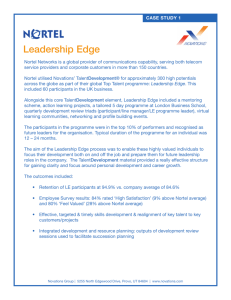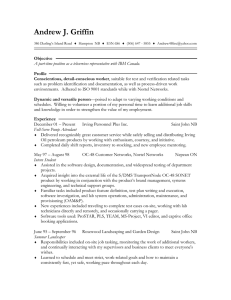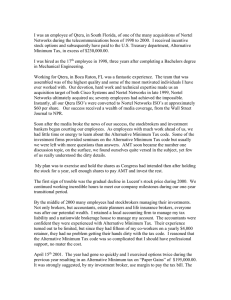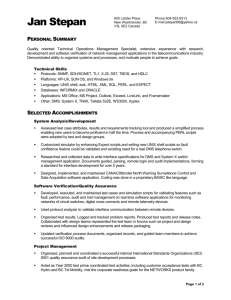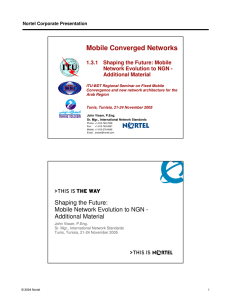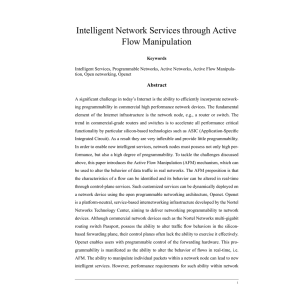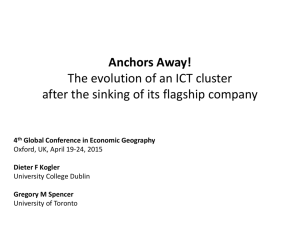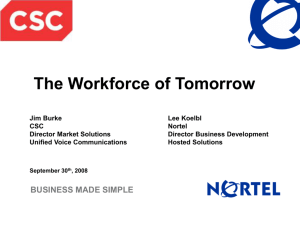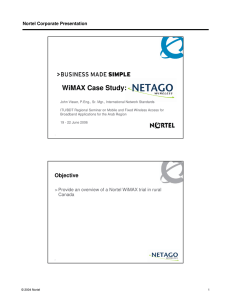Nortel Case Study - ANSI Public Portal
advertisement
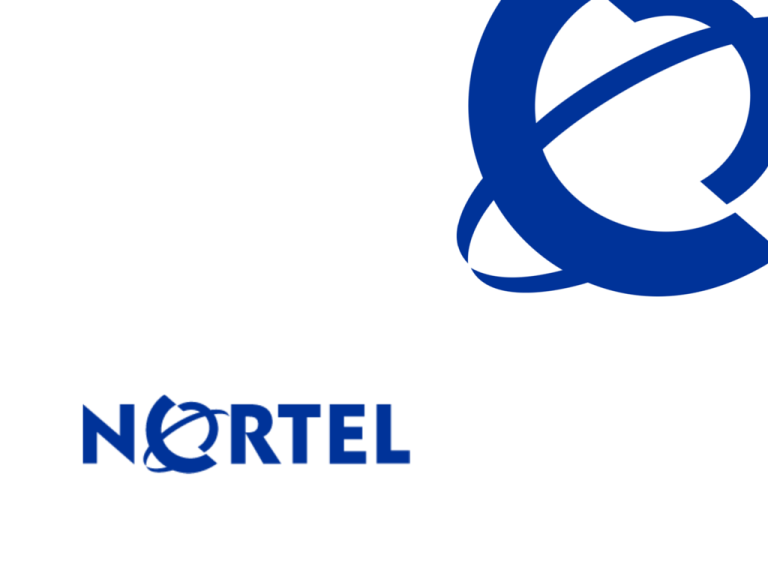
Sustainability at Nortel Rick Dipper Corporate Responsibility September 9, 2008 BUSINESS MADE SIMPLE Nortel Confidential Information Nortel’s Environmental History 2007 •Dow Jones Sustainability Index (3rd year in a row) 2005 •Top 10 Socially Responsible •Environmental Companies (Maclean’s) Innovation Award 2002 (Environment@RTP) •Most Environmentally •WEEE compliance Responsible Technology Company in Canada (Corporate Knights) 1992 •First company to eliminate 2006 CFC’s from manufacturing •Clean Air Day Award •Environmental Leadership (2006 Smog Summit) Award 1987 •RoHS compliance 2004 •Environmental audit •GreenCommute meets completed and “Best Workplaces for environmental policy Commuters” requirements established 1997 •Ozone Protection Award 1989 •USEPA Ozone Protection Award Nortel’s EARTH Principles Educate our Employees We encourage and stimulate employee participation in reducing Nortel’s environmental impact. We provide insight, data, and techniques on how employees and their families can reduce their own environmental footprint. Active Engagement and Dialogue We initiate and maintain conversations with relevant organizations, both internally and externally. We actively engage in standards development so our customers can assess our products and solutions using an unbiased and independent methodology. Reuse, Reduce, Recycle We make these three intertwined behaviors a priority, by reusing when possible, reducing consumption when appropriate, and recycling at every opportunity. Tangible and Continuous Improvement We set concrete goals and objectives that are crucial to measure progress. As we dialogue with our various stakeholders, including our Customers and Suppliers, it will be critical to show our ability to react to ideas and opportunities to improve our processes. We must listen with the intent to apply concepts and ideas which will move the yardsticks. Harmonious product design which contributes to a sustainable planet We have an engineering legacy; it is in our DNA. The design of our products and solutions does not come by accident or happenstance – it is accomplished with a clear understanding of our Customers needs and a belief in the value of our Design for Environment attributes. We strive to design solutions which reduce the environmental footprints of all who use them. Lessons Learned with WEEE/RoHS • Intelligence and Analysis • Trade associations • Provide input through external stakeholder consultations • Planning and Preparation • Leading indicators • Impact assessments • Organizational Awareness • Supply Chain –both directions • Internal information flow • Due Diligence/Follow Up • Records Management • “Rinse and Repeat” EuP, REACH, etc. require similar discipline and rigor Extending our Green Reach Associations and Standards •Principal member of the Ethernet Alliance •Driving Energy Efficient Ethernet standard •Global e-Sustainability Initiative •Promotes technologies for sustainability •American Electronics Association in Europe •Carbon Disclosure Project •Disclose greenhouse gas emissions •The Climate Group •United States Environmental Protection Agency •Climate Leaders Group Executing Green at Nortel Standards Council Regional Green Councils Design for Environment Global Green Council Government Relations Investment Recovery Centers R&D Energy Champion Many moving parts to a successful implementation Tactical Requirements • Organizational Discipline • • • • Overarching Global Green Council Functional players Strategic Partnerships Customer Engagement • Cradle to Grave mindset • Design for Environment • Product evolution • End of Life – Takeback • Support across entire enterprise • Executives on down Looking Ahead • Focus on Energy Efficiency • Reducing Costs/Carbon Footprint • Active participation in industry standards • Ahead of EuP curve • Continued Regulatory Vigilance • European Union • United States • Global • Flawless execution on Current Strategies Anticipation and early reaction are key Success requires ICT Collaboration • “We’re all in this together” • Traveling the same road…although at different rates • Sharing best paths/bumpy paths • Leverage Trade Associations to be the industry voice • Share information as necessary and appropriate • Learn from each other • Partner on common causes

